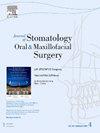应用于人牙龈成纤维细胞(HGF-1)和角质形成细胞(NOK-SI)的洗必泰和蓝®M 的细胞毒性评估:体外研究。
IF 1.8
3区 医学
Q2 DENTISTRY, ORAL SURGERY & MEDICINE
Journal of Stomatology Oral and Maxillofacial Surgery
Pub Date : 2024-10-01
DOI:10.1016/j.jormas.2024.101923
引用次数: 0
摘要
洗必泰(CHX)是控制口腔微生物群的首选。然而,它是一种化学制剂,会导致牙齿拉伤、味觉障碍和口腔粘膜脱屑等副作用。作为 CHX 的替代品,乳铁蛋白和氧基 Blue®M 的出现不会影响组织修复。因此,本研究旨在评估 Blue®M 和 CHX 对口腔人类成纤维细胞(HGF-1)和角质细胞(NOK-SI)的影响。使用 HGF-1 和 NOK-SI 进行的细胞培养评估了细胞增殖、细胞周期凋亡和坏死以及迁移。在剂量效应测试中,Blue®M 减少 HGF-1 样品的浓度是 CHX 的 4 倍(CHX:173.07 ±10.27;Blue®M:43.86 ±3.04)。增殖测试显示,CHX 可使样品的增殖率降低 8 倍,而 Blue®M 则降低了 18 倍。凋亡率和坏死率增加了 25%(p本文章由计算机程序翻译,如有差异,请以英文原文为准。
Cytotoxicity evaluation of Chlorhexidine and Blue®M applied to a human gingival fibroblast (HGF-1) and keratinocytes (NOK-SI): In vitro study
Chlorhexidine (CHX) is a prime choice to control the oral microbiota. However, it's a chemical agent leading to side effects such as teeth strains, taste disturbance, and desquamation of oral mucosa. Alternatively, the lactoferrin and oxygen-based Blue®M has been introduced as an alternative to the CHX, not disturbing tissue repair. Therefore, the study aimed to evaluate the effects of Blue®M and CHX on oral human fibroblasts (HGF-1) and keratinocytes (NOK-SI). Cell cultures using HGF-1 and NOK-SI evaluated cell proliferation, cell cycle, apoptosis and necrosis, and migration. In the dose-effect test, Blue®M reduced the HGF-1 sample in a 4-fold concentration than CHX (CHX: 173.07 ±10.27; Blue®M: 43.86 ±3.04). The proliferation test revealed an eightfold reduction of the sample for CHX, while for Blue®M, the proliferation rate was eighteen times lower. The apoptosis and necrosis rates increased by 25% (p<0.0001) for HGF-1 for both substances. In NOK-SI, the apoptosis rates increased by 10% (p=0.02) and 15% (p=0.001) for CHX and Blue®M, respectively. Furthermore, the fibroblast had a lower capacity for wound closure in the Scratch Assay (monolayer cell migration) for Blue®M. Despite the limitations of this in vitro study, the results of the lactoferrin and oxygen-based Blue®M demonstrated cytotoxicity in doses over the Minimum inhibitory concentration and Minimum bactericidal concentration for Oral fibroblasts (HGF- 1) and Keratinocytes (NOK-SI).
求助全文
通过发布文献求助,成功后即可免费获取论文全文。
去求助
来源期刊

Journal of Stomatology Oral and Maxillofacial Surgery
Surgery, Dentistry, Oral Surgery and Medicine, Otorhinolaryngology and Facial Plastic Surgery
CiteScore
2.30
自引率
9.10%
发文量
0
审稿时长
23 days
 求助内容:
求助内容: 应助结果提醒方式:
应助结果提醒方式:


